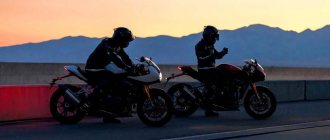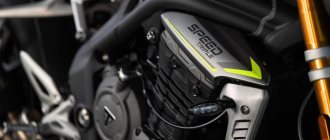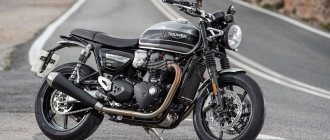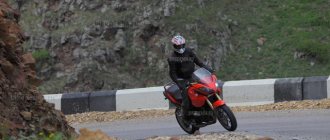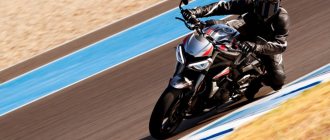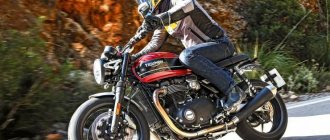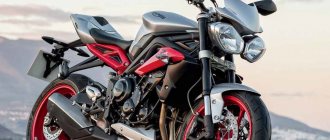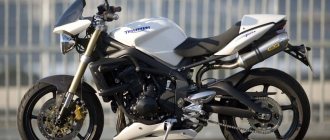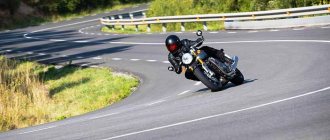Review (Test Drive)
If you're looking for a naked bike for the city and outings on everyone's favorite twisty roads, this is probably the best candidate today - the Triumph Speed Triple 1050S. But it is worth remembering one important feature. Not quite a full-fledged test drive: contrary to the practice of rolling out 5-6 tanks on a motorcycle before judging the character and characteristics, we only covered a couple of hundred kilometers with the Triumph. But these kilometers are unforgettable!
The Triumph Speed Triple 1050S is the main competitor to the BMW S 1000 R, but with a couple of caveats, which you will find at the very end of the text. So, if you don't want to read everything, scroll down.
The technical package embodied in the Speed Triple 1050S is perfect in my opinion. The seating position and weight distribution are not as radically “racing” as those of the BMW, and should appeal to those who do not intend to spend most of their time in a shrimp position. Electronic throttle, good on-board computer, switchable ABS and traction, Ohlins suspension - NIX30 series fork with a full range of adjustments, dual-chamber TTX36 at the rear; Precise Brembo M4 brakes... all this on an all-aluminum chassis perfectly copes with uneven asphalt. The rear wheel is slightly unloaded, but the front wheel is under strict control. Braking is exciting and predictable at every moment. This is enough to briefly describe the set.
The motorcycle was created not only for those who like to unscrew the handle and fight the wind, wearing a thick leather suit and a lightweight carbon integral, but also for daily trips, so it was just as comfortable in the universal Blauer textiles and the weighty Schuberth C3 Pro.
A week ago in one of the magazines I saw a big comparison of cool naked bikes, where the Speed Triple 1050S was put on the same level as the KTM 1290 Super Duke R and the BMW R1200R. In fact, Triumph's behavior is categorically different from either the KTM or the R1200R.
The narrow gas tank of the Speed Triple has a modest volume of only 15 liters, but allows the pilot to move in the saddle in all four directions and even sit almost astride it, load the front-end and excel in turns until he gets tired. On the track, the Speed Triple is probably simply unique, you should definitely try it. The balance of power and pleasure is achieved at 6000-7000 rpm, when you can drive at the torque 100% of the time and brake with the engine, practically without using the lever.
In the BMW R1200R, the fork is loaded on its own, thanks to the heavy engine and low center of mass, so the ride is initially much calmer and more comfortable: the “bimmer” picks up speed like a rocket, but smoothly and without vibrations at all. But engine braking is not what the R1200R is all about. The boxer is simply not designed for this, so the main control on the move is both levers - the clutch and the front brake.
The KTM accelerates about the same, but you don’t want to increase the revs at all due to the characteristics of the V-Twin: power of 180 hp. Enough to throw the front wheel in the air in any gear, 130 of them are already available at 4000 rpm, so you can pump up the bottom end, adding a little here and there. And engine braking is the main speed control tool here. BMW and KTM both navigate and control corners with precision, thanks to near-perfect weight distribution and engine positioning.
The BMW S 1000 R is a completely different matter. The motorcycle, originally built on the basis of a sportsbike and with all its characteristics, including full access to 198 hp, insists on taking every corner aggressively. The overhanging position over the dashboard is always a bit of an acquired taste, but it encourages more dynamic driving, both in traffic and on the highway.
However, Triumph is even more aggressive in this regard: it persistently demands an attack every time, and in such a way that at the exit it opens wider and roars more juicily.
The huge difference between Triumph and BMW is the engine! It is the 3-cylinder “Triple” with a volume of exactly 1050 cc. and a power of 138 hp. makes this motorcycle a Triumph. The engine starts the pilot, keeps him in good shape, spurs him on, motivates and excites him. The sound of work and the vibrations that 3 cylinders create gives you goosebumps – it’s just a delight!
The motorcycle's enthusiasm is enough for the pilot to roll out the rear tank almost to the side, even on public roads. And therein lies a great hidden threat.
The super torquey motor is controlled by a simple traction control system (not like BMW) with four modes: Track, Sport, Road and Rain. As the name suggests, the Track is designed for ideal asphalt, when the influence of electronics is minimal and all 138 hp are available. and 113 Nm. Realizing that we were still conducting a road test and in the hope that other test pilots would understand this, I didn’t bother with the settings - we just exchanged motorcycles and moved on. A special “thank you” to my friend Abalakin, who received the Triumph directly before me. Deciding that the Bavarian country roads were smooth enough to be called a “track”, he chose this setting and left it that way. Everything happened completely unexpectedly, as the racers say, “without warning.”
Our group walked at about 130 km/h along one of the winding highways that go around a small mountain, behind which the town of Boxberg is located. On the transition before the long and very picturesque right curve, the rear wheel decided to go into a long and not very well controlled drift. The unloaded rear wheel managed to float half a meter to the side, leaving a greasy rubber strip on the cracked asphalt. Then the electronics caught the stall and quite gently cut off the power supply, but still I was thrown up in the saddle by 20 centimeters.
I can well imagine the faces of the Japanese test rider Hiroshi, who was right behind me on a Honda, and the instructor at the end of the group on a Ducati: just 5-6 meters in front of them, Triumph performed a classic highside. I caught a glimpse in the mirrors of Hiroshi and the Master Chef clutching the brakes. I think they liked the show, and let’s put a tick in the check-list: traction control on a Triumph is mandatory and works, you shouldn’t turn it off at all, although the British flaunt this feature.
PS
Many times, traveling to the west, I saw pickup trucks with trailers loaded with a variety of “triumphs” coming towards me. And now I know why the owners did it that way. And I’m glad that I didn’t have to drive the Speed Triple 1050S under my own power for 2000 km to experience all these pleasant moments.
Speed Triple 1050S is a powerful drug that hits you instantly. But one day it may seem ordinary or even worse, tiresome. The key question is: how quickly will the owner develop a stable tolerance to this bouquet of sensations from the engine, sound and “positive vibrations”? And if it appears, then how to live further? What other motorcycle can give SO MANY emotions? Take a ride for a day - yes! But if you don’t want to spoil the impression and forever lose your taste for driving, you probably shouldn’t take the Speed Triple on a long trip with endless straight highways on the menu.
Why is the BMW S 1000 R more interesting in this sense (besides the fact that it is 60 horsepower more powerful)? It's smooth and smooth, just like the 4-cylinder inline engine itself. As a result, the driving impressions are not so bright - for the time being. But this feature is sometimes required if you want to get to the track or winding paths under your own power.
material from the page: https://www.motogonki.ru/
Triumph Speed Triple 1200 RR: premiere
The English brand presented the most dynamic motorcycle of the Speed Triple family, at least visually. Will it be able to replace the legendary Triumph Daytona?
The new product received a semi-fairing in the neo-retro style and clip-ons (125 mm lower, 50 mm forward), this formula for converting a naked into something more sporty is not new, just remember the Suzuki SV650 and SV650S, both of them were successful and had their own fans. But what else sets the Speed Triple 1200 RR apart from its stripped-down brother, the Speed Triple 1200 RS?
These include rider pegs positioned higher and further from the front of the bike, as well as semi-active Öhlins electronic suspension. This is not to say that the riding position is the same as on the reference sportbike, but now it is definitely closer to the rider’s position on the Triumph Daytona. This will reduce drag, let's not forget about the powerful 178-horsepower engine, and will also allow the motorcycle to be taken into deep turns on the track more naturally.
The electronics package includes five throttle settings, wheelie, traction and cruise control, corner ABS, quickshifter, 5-inch TFT display and My Triumph smartphone compatibility system. A factory tuning catalog of thirty items is already ready.
Sales will begin in January next year. The cost of the Triumph Speed Triple1200 RR in the US is already known: $20,950 for a gray or white-gray motorcycle, or $21,275 for a metallic red motorcycle. Of course, the price has increased by $2,650 compared to the 1200 RS, mainly due to the electronic suspension, but this is what will make the bike more versatile, suitable for both the track and the road.
Weight has also increased slightly compared to the Speed Triple RS, but only slightly, by only 800 grams.
2022 Speed Triple RR Specifications
Price in USA: $20950
Engine: DOHC, water-cooled, in-line 3-cylinder, 12-valve
Working volume: 1160 cubic meters cm.
Bore x Stroke: 90 x 60.8mm
Compression ratio: 13,2:1
Gearbox/wheel drive: 6-speed/chain
Maximum power: 178 hp. With. at 10750 rpm
Maximum thrust: 125 Nm at 9000 rpm
Power System: Multi-point sequential electronic fuel injection with electronic throttle grip
Clutch: multi-plate, oil bath, slipper
Frame: aluminum spatial, with aluminum subframe
Front Suspension: 43mm Öhlins NIX30 inverted fork with 120mm travel, fully adjustable, Öhlins S-EC 2.0 OBTi electronic compression and rebound adjustment
Rear suspension: Öhlins RSU TTX36 twin-tube monoshock with progressive linkage system, fully adjustable, Öhlins S-EC 2.0 OBTi electronic compression and rebound adjustment
Front Brake: Brembo Stylema Monoblock 4-piston calipers, dual 320mm floating discs, corner ABS
Rear Brake : Brembo 2-piston caliper, 220mm disc, corner ABS
Wheels, front/rear: cast aluminum, 17 x 3.5” / 17 x 6.0”
Tires, front/rear : Pirelli Diablo Supercorsa SP V3, 120/70ZR-17 / 190/55ZR-17
Steering angle/front reach: 23.9º/100mm
Wheelbase: 1440 mm
Seat height: 830 mm
Tank capacity: 15 l.
Curb weight: 199 kg
CHASSIS, SUSPENSION AND ELECTRONICS
FRAME Aluminum frame with bolt-on aluminum rear subframe
REAR SWIMMER Single-sided aluminum swingarm with chain tension eccentric
FRONT WHEEL Cast aluminum wheel, 17″ x 3.5″
REAR WHEEL Cast aluminum wheel, 17″ x 6.0″
FRONT TIRE Pirelli Diablo Supercorsa V3 120/70 ZR17
REAR TIRE Pirelli Diablo Supercorsa V3 190/55 ZR17
FRONT SUSPENSION Upside-down Ohlins fork with electronic rebound and compression adjustments, 43 mm travel and 120 mm travel. Öhlins S-EC 2.0 OBTi system.
REAR SUSPENSION Ohlins monoshock absorber with electronic rebound and compression adjustments, rear wheel travel - 120 mm. Öhlins S-EC 2.0 OBTi system.
FRONT BRAKE Two floating brake discs with a diameter of 320 mm, 4-piston BREMBO Stylema radial monoblock calipers, angular OC-ABS
REAR BRAKE Single 220mm brake disc, 2-piston Brembo caliper, corner OC-ABS
INSTRUMENT PANEL Color 5-inch TFT instrument panel with built-in Bluetooth module.
